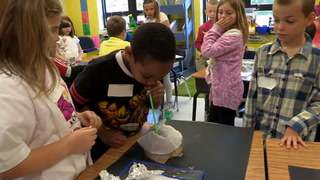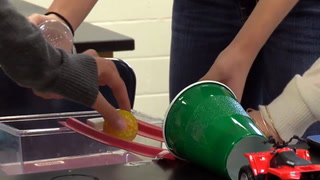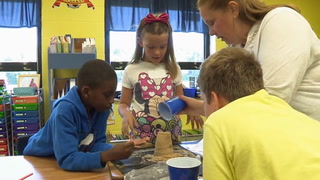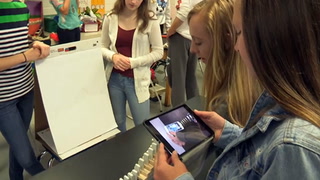First Steps Towards Transitioning to the NGSS Transcript
Speaker 1: Because they can be close to that next [car?]. And it took a little while but it fell.
Speaker 2: Do you notice, if this falls right here.
Speaker 3: I think the first thing that I would say about shifting to an NGSS centered classroom is that, designing three dimensional experiences in the classroom is really hard. There is no two ways about it. It's difficult. There are definitely things that you can do that really start that domino flowing, that spark that desire to persist as a teacher.
Does everybody feel good? You ready?
And that is to flip the way that you normally present information to students and give them an opportunity to explore and to construct some understanding before you do any explaining.
Speaker 4: So it must be like, I don't know if this is enough force.
Speaker 5: I don't think the force is [enough?].
Speaker 4: What if we had something else here that hit that?
Speaker 3: I think that that's one of the elements that's part of the spirit of NGSS in our classroom. It's that the students are really excited to explore something new because they know that we're going to end up having rich conversation and doing deep thinking around that context.
Speaker 6: We decided to compare the energy pyramid to the Rube Goldberg because the energy is constantly transferring, whether it's from the producer to the consumer to through the different steps of the Rube Goldberg.
Speaker 3: Do you want to show us an example of your steps and then maybe an example within the pyramid?
Speaker 6: Right here, when the dominoes go up the Rube Goldberg and then the ball goes down, that's the energy transferring up and then down to hit the end of our Rube Goldberg. Through this part, we have the sunlight is transferring the energy into the plant so then the other resources, like the consumers and eventually the humans can use that energy.
Speaker 3: So the second part of that is, I think that NGSS focused classrooms, students always need to be engaged in trying to explain a phenomenon or develop a solution to a problem. So I didn't scrap all of the great activities that I loved as a teacher who's taught for 20 years. But I thought about what storyline could I develop where there was something at the end that students were going to explain, that they were excited about explaining, or a problem that they were going to solve. What tools do I have in my tool belt that would really provide them with great evidence, that they could then develop that explanation with down the road?
Speaker 2: No we can relate this to the Law of Conservation of Energy, when it transfers from gravitational potential energy up here down to kinetic. Energy isn't destroyed, but it is lost to this system, such as sound and light.
Speaker 3: I think it was thinking about my class as a story and creating that full picture for students as opposed to what specific discrete pieces of content do I need to teach them?
One of the things that really facilitates that is conversation with other educators. One of the things I love about the NGSS is that it's a national common language. So I can work with teachers from all over the United States and talk about these things, and I have done that. I'll start a storyline or I'll throw something out there, and then people will point me in directions of some really great experiences that would help students get to an understanding and be able to construct and explanation.














4 Comments
Jessica Byrd Dec 14, 2022 8:30am
The students have the opportunity to explore and create their understanding of what they know.
Lauren Mullens Aug 4, 2020 1:35pm
1. The students have the opportunity to explore on their own and create their own understanding of what they think is happening before any instruction is given.
2. They have a class discussion and present situations relatable to what they think is happening in the activities they just completed.
3. I think getting student feedback on storylines they would find exciting would be one of the first steps to try since you need to keep the students engaged.
Theresa Baricovich Dec 29, 2016 5:01pm
Jean Pillsbury Jan 2, 2016 10:40am